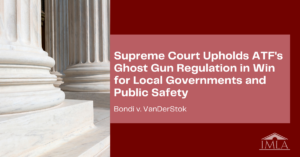27 Mar Supreme Court Upholds ATF’s Ghost Gun Regulation in Win for Local Governments and Public Safety
 Yesterday, in a win for local governments in Bondi v. VanDerStok, the Supreme Court held that the Bureau of Alcohol, Tobacco, Firearms and Explosives (ATF)’s regulation of so-called “ghost guns” did not violate the Administrative Procedure Act (APA) as the firearm part kits could be considered firearms under the statutory definitions of the GCA. This case has significant implications for public safety as before the ATF’s rule, local governments around the country had seen an exponential increase in untraceable ghost guns being used in the commission of crimes. Today’s victory means that the manufacturers of ghost guns must comply with the same requirements under the GCA to conduct background checks, keep records of sale, and serialize the firearms that other firearm manufacturers must comply with.
Yesterday, in a win for local governments in Bondi v. VanDerStok, the Supreme Court held that the Bureau of Alcohol, Tobacco, Firearms and Explosives (ATF)’s regulation of so-called “ghost guns” did not violate the Administrative Procedure Act (APA) as the firearm part kits could be considered firearms under the statutory definitions of the GCA. This case has significant implications for public safety as before the ATF’s rule, local governments around the country had seen an exponential increase in untraceable ghost guns being used in the commission of crimes. Today’s victory means that the manufacturers of ghost guns must comply with the same requirements under the GCA to conduct background checks, keep records of sale, and serialize the firearms that other firearm manufacturers must comply with.
Facts
The GCA imposes licensing, background-check, recordkeeping, and serialization requirements on manufacturers and dealers of firearms. As relevant here, the GCA defines a “firearm” to include “(A) any weapon (including a starter gun) which will or is designed to or may readily be converted to expel a projectile by the action of an explosive,” as well as “(B) the frame or receiver of any such weapon.” 18 U.S.C. 921(a)(3). Congress delegated to the Attorney General the authority to promulgate “such rules and regulations as are necessary to carry out” the Act. 18 U.S.C. 926(a). The Attorney General has in turn delegated that authority to the ATF.
Technology like 3D printing and reinforced polymers has allowed companies to manufacture and sell firearm parts kits or ghost guns that allow anyone with access to the internet and basic tools found in most homes to assemble a functional firearm quickly and easily, often in under thirty minutes. Some manufacturers of ghost guns sold these kits without complying with the GCA’s requirements by claiming that they were not “firearms” regulated by the GCA. These kits are then sold without the required background checks, records of sale, or serial numbers.
Without these safeguards in place, the proliferation of ghost guns in the commission of crimes exploded. According to the federal government, “[i]n 2017, law-enforcement agencies submitted about 1,600 ghost guns to the federal government for tracing. By 2021, that number jumped to more than 19,000.” The federal government explained that “efforts to trace the ownership of these weapons …ha[s] proven almost entirely futile.”
In 2022, the ATF issued a regulation to clarify that the definition of firearm under the GCA includes products and kits that can “readily be converted” into an operational firearm or a functional frame or receiver. The regulation also explained that the statutory term “frame or receiver” under the definition of firearm includes “a partially complete, disassembled, or nonfunctional frame or receiver, including a frame or receiver parts kit, that is designed to or may readily be completed, assembled, restored, or otherwise converted to function as a frame or receiver.” The upshot of the regulation is that manufacturers of firearm parts kits must comply with the requirements of the GCA.
The manufacturers of ghost guns filed a pre-enforcement facial challenge under the APA, arguing that in issuing the regulation, the ATF exceeded its statutory authority as the GCA could not be read to extend to weapons parts kits or unfinished frames or receivers. The Fifth Circuit agreed with the manufacturers and held the ATF’s regulation was inconsistent with the statutory text and exceeded the agency’s authority and therefore violated the APA.
In a 7-2 opinion authored by Justice Gorsuch, the Supreme Court reversed, concluding that gun part kits fall within the statutory definition of a firearm under the GCA and could therefore be regulated. The Court used one of the most common ghost-gun kits as an example to illustrate its reasoning: Polymer’s “Buy Build Shoot” kit. According to the record, the kit can be assembled in approximately 20 minutes by someone with common tools and no previous knowledge of the assembly requirements. The first question is whether under subsection A of the GCA, the kit was a “weapon,” meaning, according to the Court, “an instrument of combat.” And here, the Court concluded that the semiautomatic pistol plainly fell into that category, even though assembly is required. As the Court noted, “[r]eally, the kit’s name says it all: ‘Buy Build Shoot.’”
The Court likened the ghost gun kit to an author who asks you to read her latest novel, even though it is an unfinished manuscript. Or, the Court noted, one might refer to the kits as a “weapon” in the same way someone who just bought a table from IKEA would call it a table, even if it takes hours of assembly. The Court explained that in both examples, like the weapons at issue here, “the artifact noun fits because the intended function of the unfinished object is obvious to speaker and listener alike.”
The Court further explained that the statute itself contains additional support that the firearm part kits are weapons under the GCA. Subsection (A) of the GCA lists a “starter gun” as a weapon. And a starter gun needs work to be converted to a live firing unit, which somebody can do with no specialized knowledge. The Court reasoned that the inclusion of a starter gun in the statute indicated that “Congress used that term as an ordinary speaker might, to embrace some unfinished instruments of combat like Polymer80’s product.”
After explaining that the Polymer Buy Build Shoot kit met the definition of a weapon, the Court also found that it was also “capable of being ‘readily …converted to expel a projectile by the action of an explosive’” under the statute. Here again, the Court likened the ghost gun part kits to the starter guns listed in the statute. Both can be converted into a working firearm by a person without specialized knowledge, using everyday tools, in under an hour.
The last question was whether the ATF’s regulation addressing unfinished frames and receivers was inconsistent with the GCA under subsection (B) of the Act. The Court rejected the Fifth Circuit’s view that the Act only allows for the regulation of fully finished frames or receivers. The Court held that the ATF may regulate “at least some ‘partially complete’ frames or receivers.” Here, the Court pointed to, with the help of pictures, the difference between the Polymer80 product and a fully complete frame or receiver. The Court explained, and the pictures underscored, that the only difference was a couple of small plastic tabs on the Polymer product that are “easily removable by a person with novice skill, using common tools … within minutes.” The Court again pointed to the novel / manuscript and IKEA table analogies to support its conclusion that an object that is not yet complete could be considered a frame or receiver.
In upholding the regulation, the Court emphasized that the manufacturers brought a pre-enforcement challenge, which places a heavy burden on the manufacturers to show that the rule is “inconsistent with the statute on its face”, even if there may be possible applications of the rule which would be invalid. The Court noted there may be limits to the ATF’s regulatory authority of firearm part kits. Sticking with the author analogy, the Court noted it would be “extravagant to speak of a novel when the author has dashed off only a few lines.” The Court noted that weapons part kits vary widely, and some may require significant time and expertise. But the Court was grappling with a facial challenge and did not have those issues before it.
This case represents a significant public safety win for local governments. The Local Government Legal Center (NLC, NACo, & IMLA) filed an amicus brief in support of the regulation. The brief underscored how the GCA’s requirements protect the public through background checks, record keeping requirements, and serial numbers and that the ATF’s regulation closes a loophole that was undermining public safety in local communities.
To read the decision, click here.
To read the LGLC amicus brief, click here.



